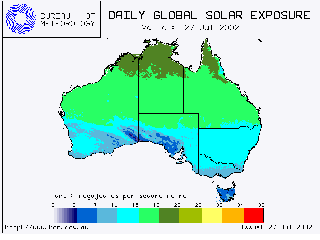 Energy generated by the sun is radiated outwards in all directions, and only a mere
two thousand-millionths is intercepted by the earth as light and infrared (heat) radiation.
The intensity of the sun's radiation (irradiance) at the top of the earth's atmosphere at
the mean distance of the earth from the sun is
roughly constant - the solar constant - with an observed value of
1366 Watts/m2 ± 0.3%.
However, on average, only about half of this energy
reaches the earth's surface.
Approximately 30% is reflected back to space, and the
remaining 20% is absorbed by clouds, dust, and "greenhouse" gasses such
as water vapour, carbon dioxide, and ozone.
[more information]
Energy generated by the sun is radiated outwards in all directions, and only a mere
two thousand-millionths is intercepted by the earth as light and infrared (heat) radiation.
The intensity of the sun's radiation (irradiance) at the top of the earth's atmosphere at
the mean distance of the earth from the sun is
roughly constant - the solar constant - with an observed value of
1366 Watts/m2 ± 0.3%.
However, on average, only about half of this energy
reaches the earth's surface.
Approximately 30% is reflected back to space, and the
remaining 20% is absorbed by clouds, dust, and "greenhouse" gasses such
as water vapour, carbon dioxide, and ozone.
[more information]Solar radiation reaching the surface is made up of two components, direct and diffuse. Direct radiation is the part which travels unimpeded through space and the atmosphere to the surface; and diffuse radiation is the part scattered by atmospheric constituents such as molecules, aerosols, and clouds. In simple terms, direct radiation causes shadows, and diffuse is responsible for sky light. The sum of the direct and diffuse components reaching a horizontal surface is global radiation. The daily global solar radiation is the total solar energy for a day. Typical values for daily global solar exposure range from 1 to 35 MJ/m2 (megajoules per square metre). The average value over the 3 lowest months (May, June, and July) in Armidale is 10.9 Mj/m2. This is equivalent to a power output of 0.3 Kw averaged over 10 hours.
